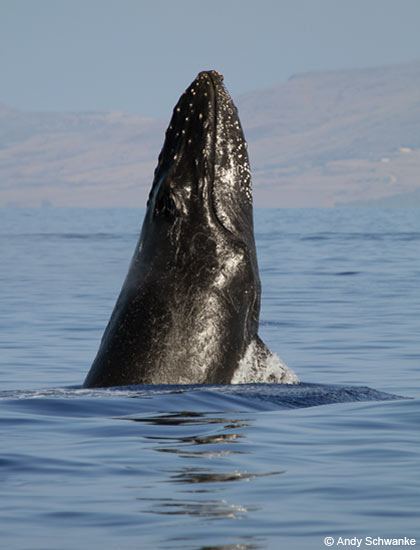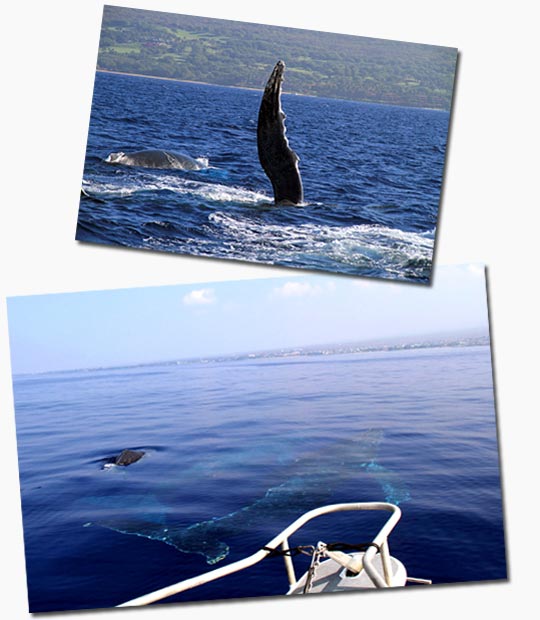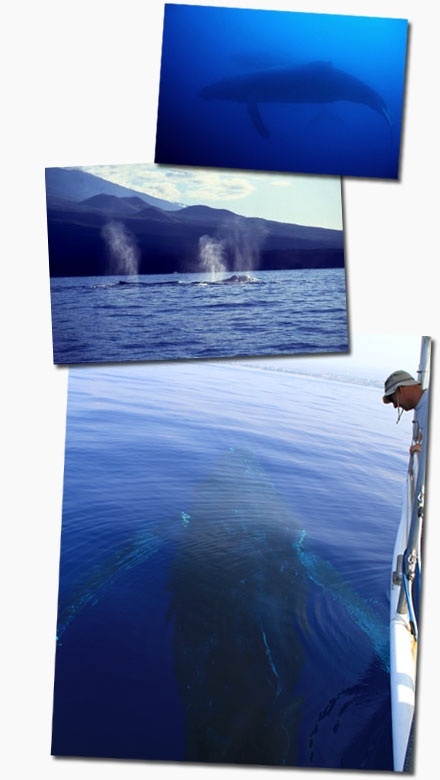
Maui Whale Season Diving
If you are serious about seeing humpback whales in their Hawaiian mating and calving grounds, the last couple weeks in February and the whole month of March are the best times to be here for Maui whale season diving. It is just about impossible for us to go out on the boat during this time and not see their above-water displays and hear their songs underwater. Although the first whales to arrive in Hawaiian waters are generally sighted in October or November, it is not until February-March that we can count on seeing them. After that, sightings taper off until the last ones leave in June, but we stop seeing them regularly long before this. So come during the peak of the Maui whale season!
Humpback whales are one of the few marine mammals’ divers and snorkelers are likely to see while in Hawaii. Fortunately for us, they tend to stay near shore in relatively shallow water increasing our chances of spotting them.
Humpback whales are just about the biggest animals to be seen in Hawaii – on land or underwater. Females are slightly larger than males and can reach over 60 feet in length. Weighing up to a ton a foot means that you could be looking at 120,000 pounds of whale! Their lifespan, while not known for certain, is impressive as well – possibly as long as 70 years.


The scientific name, Megaptera novaeangliae, means “great wings of New England,” and refers to their extraordinarily long pectoral fins. As the name suggests, they are found off the coast of New England as well, and populations exist in all the world’s oceans. The whales that come to winter in Hawaii spend their summers in Alaska feeding on the rich supply of schooling fishes such as herring and smelt. They consume enough during these months to support them during the winter months in Hawaii, where it is believed they do not eat.
As winter approaches, the whales begin heading to Hawaii, a 3,500+ mile trip that takes an unknown amount of time (although one whale swam it in less than forty days). It is not known how they find their way. Possibilities include using the earth’s magnetic field, sounds, temperature, and currents.
Each year the whales make this amazing journey in order to give birth in the comparatively warm, predator-free waters. In their feeding grounds of Alaska, cold water and killer whales would reduce the survival rate of the calves. Naturally, the males migrate to be near the females and be accessible for mating as soon as the females are ready. Often a group of three whales is sighted – a mother, a calf and a male “escort.” This male escort is not traveling along for the benefit of the calf which is almost surely not his (since males and females do not form lasting pairs) but may be waiting for a chance to mate with the adult female.
Researchers learned that is was possible to identify individual whales using the pattern on the underside of the tail fin or flukes. Using this system, they have learned that females give birth every second or third year. A gestation period of 10-12 months means that a successful mating one year will result in giving birth the next winter when the female is in Hawaii.
The fact that mating and calving occur in Hawaii enhances whale watching here. Calves must breathe every three to five minutes meaning that the mother also spends more time at the surface. But the really rowdy actions come from competition among males for access to females. Jockeying for position closest to a female can create a lot of white water and exposed fins and tails, as well as what we humans would call “body slamming”. A female can join in by rebuffing males with slaps of the entire tail and back half of her body or by slapping her long pectoral fin on the water in a possible courtship display. But, since no one has yet witnessed mating it is not known what the outcome of pec-slapping might be!
The most spectacular sight – a breaching whale – is still a mystery. Although many theories have been proposed, it is not known exactly why whales expend so much energy propelling themselves completely out of the water. One explanation is that they are signaling their presence to boats or other whales. Another is that they may be looking above the ocean’s surface.
In addition to the fantastic above-water displays, divers and even snorkelers are fortunate to be able to hear the sound frequencies that whales produce. You can hear what it sounds like by visiting The Whalesong Project website where they stream live whale sounds from Maui over the internet. Humpback whale songs are extremely complex, last between 6 and 18 minutes and can be repeated over and over again. One very unusual characteristic is that the whale song of the entire Northern Pacific population changes as the breeding season progresses so that the song at the end of the year is very different from that at the beginning. When the whales return to Hawaii the following year, they are singing the song as it was at the end of the previous year. After a few years, the song is barely recognizable.

Sometimes it is necessary for divers to stay completely still and get away from other divers exhaling in order to hear them. Other times the sound is so loud that your entire chest cavity vibrates as when the bass drum in a marching band passes by. These sometimes musical, sometimes cow-like, songs are produced by the male whales primarily during the breeding season, so it is thought that they have some reproductive purpose. They could be attracting females or letting other males know where they are. Other less complex sounds are used by both males and females to communicate other information.
Hawaii’s whale population is reportedly increasing at a rate of about 7% a year which means every year our sightings and encounters increase. Roughly 10,000 whales are thought to migrate to Hawaii each year, and although the increase is promising, they are still an endangered species and are protected by federal law from harassment. In Hawaii this means that we must stay a minimum of 100 yards away whether swimming, paddling a kayak or driving a boat. Aircraft must stay 1,000 feet above whales. For us on Maui, this is not a hardship. Whales regularly come close to anchored boats and sometimes stay for quite a while.
And, finally, there is a chance to see them while diving. With each year during the Maui whale season, as the population has increased, our chance of seeing them while diving has increased as well. Years ago, we would be lucky to see them even once while diving, but now we are lucky to see them numerous times during a season. A once-in-a-lifetime experience for most divers.
Recently the Hawaiian Islands Humpback Whale National Marine Sanctuary has been established to coordinate protection (of the whales), education (of people) and research. Even though this Sanctuary currently includes areas around Lanai, Molokai, and Kauai, in addition to Maui waters, Maui is by far the best area for whale watching, as evidenced by the number of researchers and whale watch boats headquartered here.
Photographing whales on the surface:
If you want to get great photos of whales, here are some tips:
*Come during peak season armed with a 35 mm SLR camera. *You must be able to set a fast shutter speed for their above-water displays – at least 1/500th of a second – or your photos will be blurred. *An 80-200 mm zoom lens with a polarizing filter will enhance the blue and cut the glare out on the ocean. *Keep the horizon level in the shot and hold your breath!
